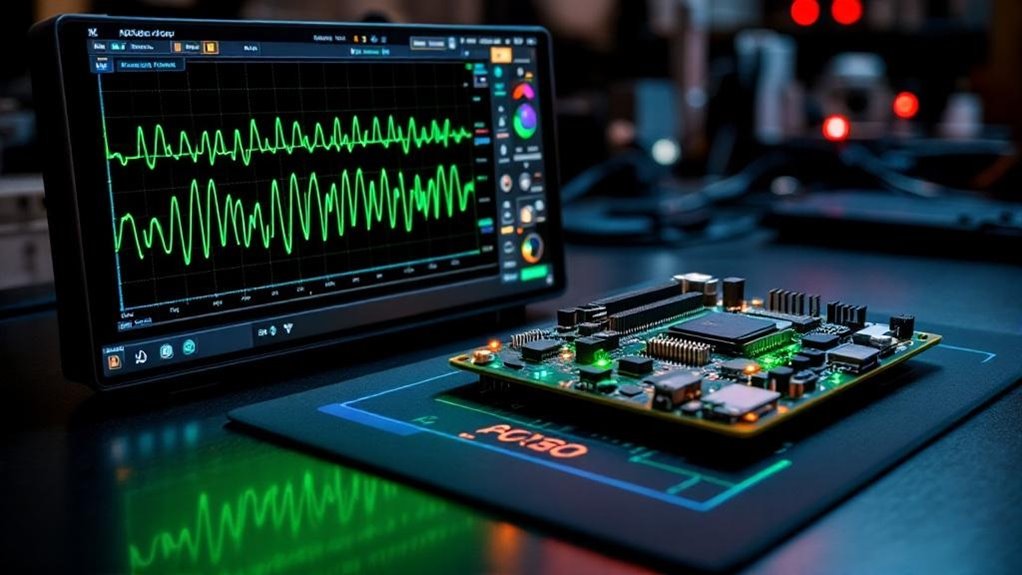Real-time signal processing implementation requires systematic consideration of interconnected system elements, including hardware selection, algorithm development, and enhancement strategies. The process begins with careful architecture planning, focusing on signal flow and data conversion methodologies, while incorporating digital signal processors and advanced filtering techniques for peak performance. Rigorous testing protocols, including hardware-in-the-loop validation and automated frameworks, guarantee reliability and efficiency. A thorough understanding of these foundational elements releases the full potential of real-time signal processing systems.
Key Takeaways
- Select appropriate hardware components with focus on deterministic execution, processing throughput, and compatibility with real-time signal processing requirements.
- Implement efficient algorithms using optimized techniques like SIMD instructions, hardware acceleration, and specialized DSP processors for maximum performance.
- Utilize double buffering and interrupt-based sampling techniques to ensure smooth real-time I/O management and minimize data processing latency.
- Conduct thorough testing through hardware-in-the-loop simulation, signal replay, and automated testing frameworks to validate system performance.
- Monitor system performance continuously through field testing and remote telemetry while maintaining comprehensive documentation for long-term reliability.
System Architecture Fundamentals

The architectural foundation of real-time signal processing systems demands meticulous consideration of multiple interconnected elements working in precise coordination. This foundational framework encompasses critical aspects of signal flow, data conversion, and processing methodologies that must operate seamlessly to achieve ideal performance. The system relies on digital signal processors for performing rapid mathematical operations on incoming data streams. Advanced processing workflows leverage SciPy libraries for efficient signal transformation operations.
Effective functional partitioning establishes discrete processing blocks, enabling modular design approaches that facilitate system maintenance and upgrades. The architecture implements strategic data routing paths that minimize latency while maintaining signal integrity throughout the processing chain.
The system’s core structure integrates analog front-end processing with digital computation capabilities, requiring careful separation to prevent interference. Memory resources, processing engines, and I/O interfaces must be precisely balanced to prevent bottlenecks.
Critical architectural considerations include:
- Synchronous sampling mechanisms
- Strategic buffering implementations
- Direct Memory Access channels
- Interrupt-driven frameworks
- Anti-aliasing provisions
- Real-time processing guarantees
Hardware Selection and Setup
Building upon the established architectural framework, selecting and configuring appropriate hardware components represents a foundational step in constructing robust real-time signal processing systems. The selection process demands rigorous evaluation of hardware compatibility and interface requirements across multiple platform options, from DSPs to FPGAs, each offering distinct advantages for specific applications. Low overhead requirements must be prioritized when evaluating hardware options to maintain optimal performance. Adaptive filtering techniques play a crucial role in optimizing system responsiveness across varying signal conditions.
| Platform Type | Key Advantages | Primary Applications |
|---|---|---|
| DSPs | High Performance, Time-to-Market | Real-time Audio/Signal Processing |
| FPGAs | Parallel Processing, Customization | Complex Signal Analysis |
| MCUs | Cost-Effective, Integrated ADC/DAC | Moderate Processing Tasks |
Critical considerations include deterministic execution capabilities, processing throughput requirements, and power consumption parameters. System designers must evaluate peripheral integration needs, focusing on ADC/DAC specifications, communication interfaces, and debugging capabilities that align with project objectives. The implementation of RTOS functionality further enhances system reliability through precise task scheduling and resource management, ensuring consistent real-time performance across all processing channels.
Algorithm Development Workflow

Successfully developing real-time signal processing algorithms requires a systematic workflow that includes multiple stages from initial conception through final deployment. The process begins with extensive requirements analysis and problem definition, establishing clear performance metrics and simulation benchmarks that guide subsequent design decisions.
The workflow proceeds through rigorous algorithm suitability assessment, where computational complexity, memory requirements, and real-time constraints are evaluated against system specifications. Engineers must analyze candidate algorithms through modeling and simulation platforms like MATLAB or Simulink, validating functional correctness and timing behavior. Effective development strategies must account for irregular sampling rates when processing real-world sensor data. Modern development environments leverage cloud-based platforms to enhance computational capabilities and enable seamless collaboration across teams.
Thorough evaluation of algorithms against system requirements ensures optimal performance through simulation-based validation and timing analysis.
Rapid prototyping and validation follow, utilizing hardware-in-the-loop testing to verify performance under actual operating conditions.
The final stages involve deployment preparation, where code optimization and system-level testing guarantee robust operation with streaming data inputs.
Documentation accompanies each phase, capturing design decisions, validation results, and configuration parameters necessary for production implementation.
Performance Optimization Strategies
While real-time signal processing demands precise algorithmic implementation, achieving ideal performance requires systematic optimization across multiple system layers. This optimization framework encompasses hardware acceleration, code efficiency, and resource management strategies.
Performance enhancement begins with hardware-level optimizations, including SIMD instructions and specialized DSP processors that enable parallel data processing. Memory alignment and strategic cache utilization markedly reduce data access latency, while code inlining eliminates function call overhead and exposes additional compiler optimization opportunities. Control flow operations in loops introduce significant overhead that must be carefully managed for optimal execution speed. Modern neural networks have revolutionized signal detection by processing complex waveforms with unprecedented accuracy and efficiency.
Real-time I/O management leverages interrupt-based sampling and double buffering techniques to maintain consistent processing rates. DMA transfers offload data movement operations, freeing CPU resources for critical signal processing tasks.
Profiling tools identify performance bottlenecks, enabling targeted optimization efforts. Loop unrolling, common subexpression elimination, and compiler optimization flags further enhance execution speed, while careful memory management prevents fragmentation and unpredictable delays that could compromise real-time performance requirements.
Testing and Deployment Methods

Rigorous testing and deployment methodologies form the foundation of reliable real-time signal processing implementations. The extensive validation process encompasses HIL testing for hardware integration, automated testing frameworks for continuous verification, and signal replay capabilities for deterministic evaluation.
Modern signal processing systems require sophisticated testing approaches across multiple phases:
Signal processing systems demand robust testing strategies throughout development to ensure optimal performance and reliability.
- HIL testing enables early detection of integration issues while validating algorithm performance under realistic conditions.
- Automated testing frameworks facilitate continuous integration through parameterized test suites and systematic regression analysis.
- Signal capture and replay mechanisms guarantee thorough algorithm validation against real-world data sets.
Fixed-point arithmetic testing is essential for verifying computational efficiency and precision management in embedded systems. Field monitoring and compliance testing represent critical final phases in the deployment lifecycle. Through staged rollouts and remote telemetry, organizations can monitor system health and performance metrics while guaranteeing adherence to regulatory standards.
This systematic approach to testing and deployment maximizes reliability while minimizing the risk of post-deployment issues in production environments.
Frequently Asked Questions
How Do You Handle Buffer Overflows in Real-Time Audio Processing Systems?
Effective buffer management in real-time audio systems requires a multi-layered approach to overflow prevention.
Systems employ predictive algorithms to monitor buffer levels and implement dynamic adjustments to processing parameters when capacity limits are approached.
Critical strategies include adaptive buffer resizing during peak loads, load-shedding mechanisms to discard non-essential data, and automated failsafe routines that reset buffers when necessary.
Hardware-software clock synchronization maintains consistent data flow rates, minimizing overflow risks.
What Alternatives Exist When Hardware Interrupts Are Unavailable on Target Platforms?
Like a well-orchestrated symphony where musicians must stay synchronized without a conductor, systems without hardware interrupts can maintain precise timing through alternative methods.
Key approaches include implementing polling mechanisms for periodic status checks, utilizing software timers for scheduled events, employing priority scheduling within RTOS frameworks, and adopting event-driven architectures.
These solutions, while potentially less efficient than hardware interrupts, provide reliable alternatives for real-time task management and synchronization on platforms with hardware limitations.
Can Machine Learning Models Be Integrated Without Compromising Real-Time Performance Requirements?
Yes, ML models can be effectively integrated while maintaining real-time performance through strategic model optimization and latency management approaches. This includes:
- Implementing lightweight architectures like decision trees or pruned CNNs
- Utilizing edge processing hardware and dedicated AI accelerators
- Employing model compression and quantization techniques
- Leveraging parallel processing capabilities
These methods have demonstrated success in applications requiring sub-millisecond response times while maintaining detection accuracies up to 95%.
How Do You Determine Optimal Block Sizes for Streaming Data Processing?
Like a maestro finding the perfect tempo for an orchestra, determining ideal block sizes for streaming data processing requires careful balance.
The process involves:
- Starting with small block sizes (50-100ms) and incrementally increasing while monitoring performance metrics
- Measuring throughput gains versus latency impact at each increment
- Testing under actual workload conditions until diminishing returns occur
- Considering system constraints like memory and network bandwidth
- Adjusting dynamically based on incoming data rates and processing requirements
What Debugging Strategies Work Best for Timing-Related Issues in DSP Systems?
Effective debugging of DSP timing issues requires a systematic approach combining timing analysis tools and latency measurement techniques.
Key strategies include:
- Using hardware timers and logic analyzers to profile critical code sections
- Implementing trace points for external instrumentation monitoring
- Deploying real-time debugging tools that maintain system timing integrity
- Conducting rigorous latency measurements across different operating conditions
- Comparing actual execution times against theoretical timing models and constraints
These methods enable precise identification and resolution of timing-related anomalies while maintaining system performance.
Conclusion
Like a well-oiled machine, real-time signal processing demands meticulous attention across system architecture, hardware configuration, algorithm development, optimization, and testing protocols. Success requires balancing computational efficiency with implementation practicality while maintaining strict performance requirements. Through careful consideration of the outlined methodologies and best practices, engineers can develop robust real-time signal processing solutions that meet demanding industrial and research applications.
References
- http://students.aiu.edu/submissions/profiles/resources/onlineBook/H7Y7t7_Real-Time_Digital_Signal_Processing_Applications-_3rd.pdf
- https://dl.icdst.org/pdfs/files/e51100ce301ad56951e4511a9a1c66aa.pdf
- https://www.matlabexpo.com/content/dam/mathworks/mathworks-dot-com/images/events/matlabexpo/in/2017/designing-implementing-real-time-signal-processing-systems.pdf
- https://www.wiley.com/en-us/Real+Time+Digital+Signal+Processing:+Fundamentals
- https://schaumont.dyn.wpi.edu/ece4703b21/lecture5.html
- https://www.wiley.com/en-hk/Real+Time+Digital+Signal+Processing:+Fundamentals
- https://www.analog.com/en/lp/001/beginners-guide-to-dsp.html
- https://www.tek.com/en/documents/primer/fundamentals-real-time-spectrum-analysis
- https://www.hwe.design/design-fundamentals/embedded-system-basics/realtime-processing
- https://www.ti.com/cn/lit/wp/spra879/spra879.pdf

